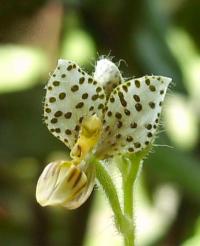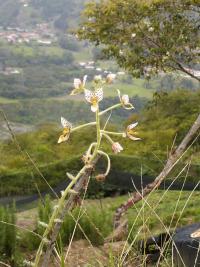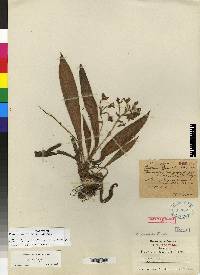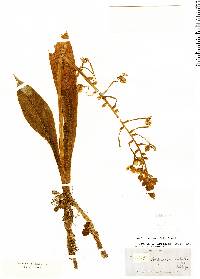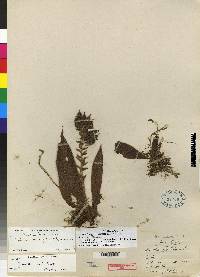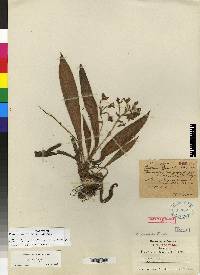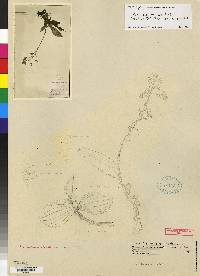
|
Family: Orchidaceae
[Ponthieva maculata Lindl.] |
Plant up to about 50 cm tall. Leaves 2–4, basal, erect to suberect, conduplicate; blade up to 37 cm long and five cm wide, lanceolate, elliptic-lanceolate, or oblanceolate, acute to abruptly acuminate, gradually tapering to a sessile base, densely pubescent. Peduncle erect or slightly arcuate, with one or two sheaths, villose throughout, terminated by a loosely many-flowered raceme. Flowers rather large for the genus, yellow-green with brownish to purplish veins and spots, sepals villose on the outer surface. Floral bracts up to 12 mm long, erect, lanceolate, cucullate, acute or shortly acuminate. Pedicellate ovary up to 27 mm long, delicate. Dorsal sepal up to 16 mm long and four mm wide, narrowly elliptic, concave, acute, 3- or 5-veined, veins branching or simple. Petals unguiculate; claw free part two to three mm long; blade up to 12 mm long and three mm wide, dolabriform to oblong lanceolate, obtuse, 1-veined, basally branching, margins glabrous. Lateral sepals up to 16 mm long and nine mm wide, free to the base, spreading, broadly elliptic to obovate, slightly oblique, acute or obtuse, sparsely papillose within, 3- or 5-veined, veins branching or simple. Lip up to 4.2 mm long and two mm wide, sessile, reddish green to orange in color, light pink in dried condition, conduplicate-cymbiform, abruptly acuminate, when expanded cuneate in outline, truncate in front, apiculate in the middle, fleshy, basally provided with a transverse, grooved plate, both sides of which are long-decurrent towards middle of disc. Gynostemium ca five to seven mm long, clavate, stalked, stalk ca (2.5) 4–5 mm long (Figs. 27 and 28). Ecology: Terrestrial in montane forest. Ames & Correll (1952) reported also epiphytic populations from Guatemala. Flowering throughout the year. Notes: Foldats (1969) synonymized under this species two Central American taxa— P. formosa Schltr. and P. brenesii Schltr., while Garay (1978: 217) synonymized P. wallisii Rchb.f. In our opinion, however, P. brenesii is rather conspecific with P. villosa, characterized below, as both species have inflorescence shorter than leaves. |



